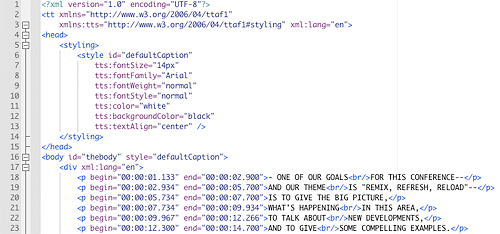How It's Done: Recorded Captions

Sample caption file in Timed Text (TT) format
First, either obtain or create a transcript. (You can create one during the process if need be, but it may add to your time on task.) Ideally the transcript is the verbatim text, rather than a script. A complete transcript reduces the project’s production time and cost, as it enables the caption editor to efficiently cut and paste the text. A script will require the caption editor to use the audio information to determine where to add or change content.
Next you need to set up the captions' timing using caption editing software. You can either use an online program or install one on your computer or network. (Module 3 covers this in more detail.)
Rather than synchronizing captions to the video’s timecode, as is done for TV captions, web captions are typically based on the video's start time. The caption editing software enables you to enter lines from the transcript at appropriate times based on their distance from the first frame of the video file. (This is one of the reasons why you shouldn't set the captions until after you have your absolute final version of the video!)
Complex video with rapid-fire dialog, a mix of dialog and music, or lots of cut-ins or edits) may require extremely precise timing to avoid overlap – even to the millisecond.
At the end, your caption editor will output the captions as a single file. The file format needed will depend on the player that will be used to display the video.

